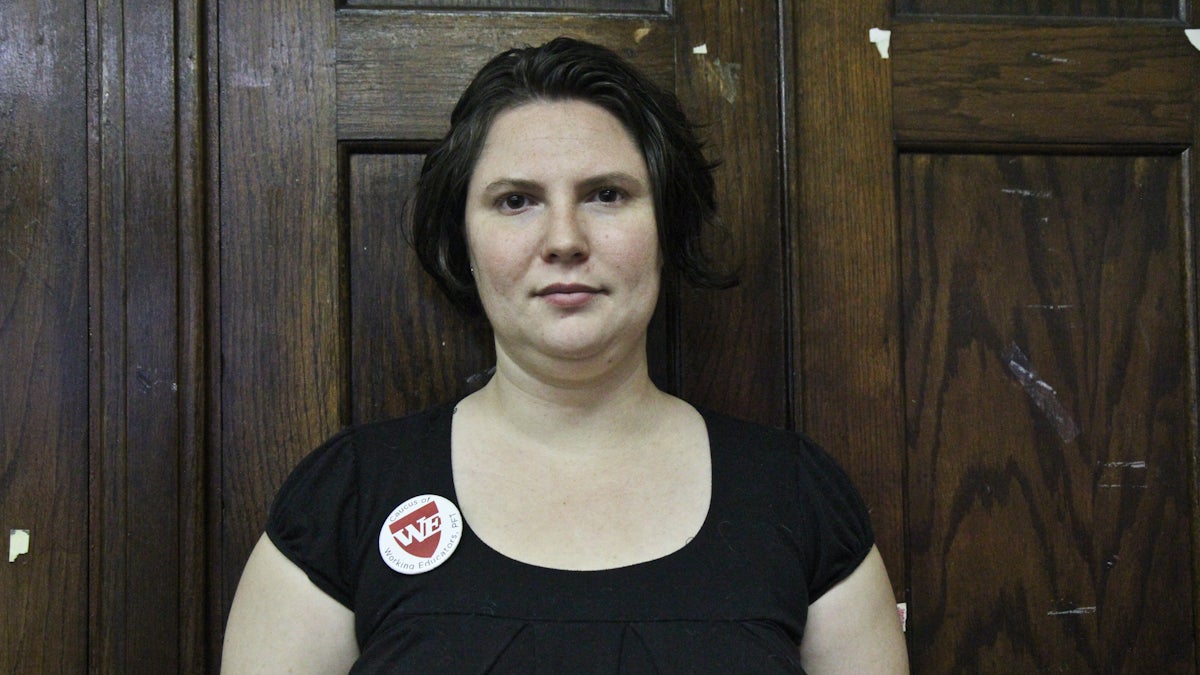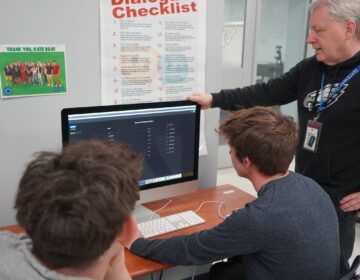Outsourcing substitute duties burdens Philly teachers, students
Listen
Penn Treaty High School teacher Kristin Combs is calling for the district to cancel its outsourced substitute teachers contract. (Kimberly Paynter/WHYY)
The Philadelphia School District took a big risk last summer.
In an attempt to boost the number of substitute teachers willing to come to its schools, it decided to outsource the service to a private firm, Source4Teachers.
Through the first four months of classes, that decision has proved to be extremely unwise – causing an uproar at many schools across the city and calling into question the viability of academic offerings.
In off-the-record conversations, many principals and teachers complained of a disastrous impact on classrooms. A system already fragile from years of resource deficiencies has been further stressed, leaving many students without continuity or stability.
While many educators declined attribution in fear of retaliation from the district, a few have been willing to speak out, including Penn Treaty math and science teacher Kristin Combs.
At Penn Treaty, a grades six-through-12 neighborhood school in Fishtown, Combs said only six substitute teachers total have come to the school all year.
Nearly every day, the permanent teachers have to use prep periods to stand in for vacancies.
“That means that we’re basically all covering all the time,” said Combs.
Seeing the logistical nightmare that’s thrust on her colleagues, Combs has wrestled with herself for months about taking any time away from work.
“I’m having such intense guilt about ever being out of school,” she said. “I have this doctor’s appointment that I’ve been supposed to be having for months that I’ve been putting off and putting off and putting off.”
When Combs finally decided to make the appointment, she felt horrible.
“I feel like I’m completely letting my kids down. And that’s insane,” she said. “It’s insane that I feel that much guilt about going to a doctor’s appointment that I need to go to.”
From 64 percent fill rate to high of 37
Last school year, on average, when a teacher in the Philadelphia School District called out, the spot was filled 64 percent of the time.
It was that far-from-stellar track record that pushed district leaders to ink a $34 million deal in June with the Cherry Hill-based Source4Teachers. The two-year pact was promised to save the district $2 million.
In April, Naomi Wyatt – then the district’s chief talent office, since promoted to chief of staff – told reporters that the district simply hadn’t done a good job finding and placing subs in recent years.
Daily attendance for Philadelphia teachers was good compared with other large urban districts, she said, blaming the substitute problem partly on cuts to central administration.
“The pool has shrunk, and our ability to manage the pool has diminished,” she said.
In April, Wyatt offered the same lament that many educators are making now.
“When you are at bare-bones staffing, and now you don’t have a sub, it really creates an extra workload on everybody in that building,” she said.
Citing Kansas City, Baltimore, Detroit and Cleveland as other big city districts to make a similar move, Wyatt stressed that the district would only contract with a firm that could deliver a better result without adding cost.
Responding to a request for qualifications, Source4Teachers promised a 75 percent fill rate on the first day of school and 90 percent rate by January.
After reaching a deal, district leaders praised the private firm, promising naysayers that it would do “an excellent job.”
But through the first few weeks of school, Source4Teachers’ fill rate hovered in the teens – leaving even esteemed magnet schools scrambling to cover leaderless classrooms.
Recently, after weeks and months of slow upticks, the rate peaked at 37 percent.
But even that figure masks the paltry fill rates at many individual city schools deemed unattractive by would-be subs – a problem that Wyatt and other leaders had hoped outsourcing would solve.
“They didn’t look at a provider that was working in comparable districts,” said Combs. “They looked at a provider that was working in small suburban districts. And providing substitutes to small suburban districts is just not the same.”
Combs, a member of the Caucus of Working Educators and a recent Green Party candidate in City Council’s at-large race, is one of many to denounce the Source4Teachers contract.
Council President Darrell Clarke has criticized the decision, and advocates testifying at School Reform Commission meetings have cried for decision makers — including Wyatt and Superintendent William Hite — to face consequences.
Further complication
In schools, the problem has been compounded by the fact that it’s proved just as difficult for Source4Teachers to fill long-term vacancies.
At Penn Treaty, there have been as many as four unfilled long-term positions at the same time. Add a daily absence or two on top of that, and real questions are raised about the school’s ability to teach the curricula.
A recent visit occurred on a day when the school needed eight substitutes, but received none.
Two of the absences that day were due to long-term vacancies; two were due to teachers attending professional development conferences; two because of illness; one for a teacher attending his mother’s funeral; and another due to a teacher chaperoning a class trip.
At Penn Treaty, many of the added coverages have fallen on Yomari Kiefer, a certified special-ed teacher, who’s been forced to also take over teaching junior and senior level English courses because of ongoing long-term vacancies.
“I’m in an area that I’m not certified in, creating lessons so the kids are getting something,” she said.
Each day after work, Kiefer struggles to keep up with her special-ed caseload while trying to teach herself the content of the next day’s English lessons – no small feat for a mom of two children under the age of two.
“It’s hard, and I know it’s impacted them because I’m not there as much,” said Kiefer. “And when I am there – I’m physically there – but I’m not really there with them.”
In conversation, Kiefer looked exhausted, with tears often welling in her eyes. She said students have commented on how worn down she looks, and she pined a little for her previous job in sales.
“It’s never ending, the amount of time it consumes in my life. I just want a job sometimes that I can just leave at the job, and just go home and be me,” she said. “There are days when I’m like, ‘Do I really want to be here anymore? Is this really what I want to do for the rest of my life?’ But obviously I do, because I come back.”
Staying the course
District officials have expressed displeasure with Source4Teachers performance, but Hite said it would be a step backward to cancel the contract and revert to the old method, which employed subs at higher pay with union protections.
Hite pledged, though, that the district would take back responsibility for long-term subs. He’s also pointed out that it’s the private firm — not the district — that’s on the hook to pay teachers extra to cover vacancies during their prep periods.
The contract also includes financial penalties for underperformance.
At a November School Reform Commission meeting, Source4Teachers CEO Kendley Davenport said he’s confident in the firm’s long-term success.
“I want to publicly acknowledge that Source4Teachers has underperformed,” he testified over the boos and shouts of the raucous crowd. “We have got to do better, and we will do better.”
Addressing its underwhelming record, the firm has taken steps to increase its fill rate by boosting its advertising budget, increasing pay, and slashing the amount of time would-be subs need to wait before being placed in schools.
Meanwhile, although the rate has been trending upward, teachers including Kiefer say they worry most about the toll the privatization has already taken on students.
“I was talking to them, and I said, ‘You know, you guys really need to apply yourselves a little bit more,'” Kiefer said. “And they said, ‘Why? Nobody else cares. So why should we care?’ And that really stuck with me … They see it as nobody wants to be here for them.”
WHYY is your source for fact-based, in-depth journalism and information. As a nonprofit organization, we rely on financial support from readers like you. Please give today.





